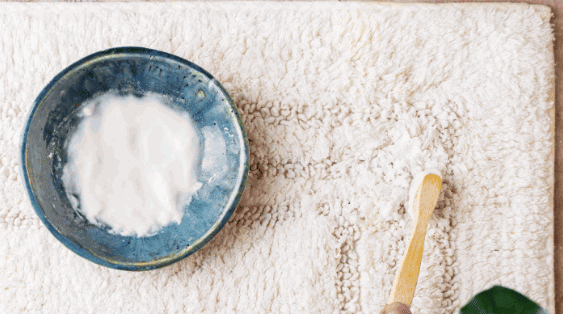
Are you tired of spending money on expensive carpet cleaning solutions that are filled with harsh chemicals?
Have you ever considered making your own homemade carpet cleaning solution?
Not only is it cost-effective, but it is also environmentally friendly and customizable for different types of stains.
In this article, we will explore the ingredients needed to create a homemade carpet cleaning solution, the steps to making it, and tips for effectively cleaning your carpets.
Say goodbye to store-bought solutions and hello to a natural alternative that will leave your carpets looking fresh and clean!
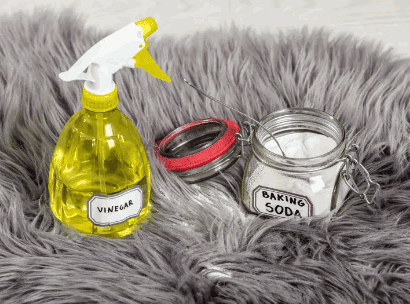
Table of Contents
A carpet cleaning solution is a specialised formula designed to effectively clean and remove stains from carpets and rugs.
These solutions are carefully formulated to target different types of stains, whether it's pet messes, food spills, or general dirt build-up. The powerful ingredients in the solution work together to break down the stains and lift them from the carpet fibres, restoring the carpet's original appearance.
Using a carpet cleaning solution regularly is crucial in maintaining the cleanliness and longevity of your carpets. Not only does it eliminate visible stains, but it also helps to remove deep-seated dirt and bacteria that may be lurking within the fibres.
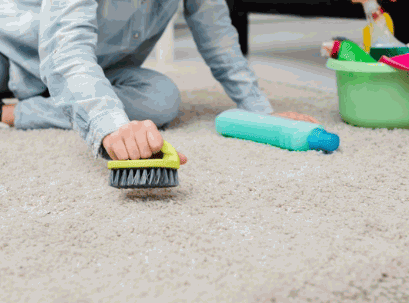
Using a homemade carpet cleaning solution offers several benefits that make it a preferred choice for many individuals.
One of the primary reasons to opt for a homemade carpet cleaning solution is its cost-effectiveness compared to commercial products.
Using common household ingredients like vinegar, bicarbonate of soda, and washing-up liquid can be highly economical when it comes to cleaning your carpets.
Homemade solutions not only save money but also eliminate the need for frequent trips to the shop for expensive cleaning products. These DIY remedies are often gentler on carpet fibers, making them a practical choice for regular maintenance.
Homemade carpet cleaning solutions are environmentally friendly as they reduce the use of harsh chemicals and minimise environmental impact.
By opting for natural ingredients like vinegar, bicarbonate of soda, and essential oils, you not only ensure a cleaner environment, but also promote sustainable cleaning practices. These homemade solutions not only effectively clean your carpets but also contribute to a safer living environment for your family and pets. Natural ingredients are gentle on carpet fibers, prolonging their lifespan and reducing the need for harsh chemical treatments that can harm the environment. Transitioning to homemade solutions for carpet maintenance is a small yet impactful step towards a greener, healthier home.
Homemade carpet cleaning solutions offer the advantage of being customisable to tackle various types of stains effectively.
For instance, to combat a red wine spill, a mixture of fizzy water and mild washing-up liquid can be effective in lifting the stain. For greasy stains like fat or butter, a combination of bicarbonate of soda and vinegar can work wonders due to their grease-cutting properties.
Alternatively, for pet urine accidents, a solution of water, white vinegar, and a touch of bicarbonate or soda can help neutralise the odour and remove the stain without harsh chemicals that pets may be sensitive to.
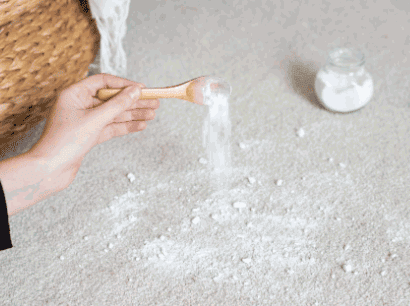
The ingredients of a homemade carpet cleaning solution typically include common household items that are effective in cleaning and removing stains from carpets.
Bicarbonate of soda is a versatile ingredient in homemade carpet cleaning solutions, known for its ability to absorb odours and lift stains effectively.
One of the remarkable properties of bicarbonate of soda is its natural ability to neutralise odours that can get trapped in carpet fibres over time. By simply sprinkling a generous amount of bicarbonate of soda onto the carpet surface and letting it sit for at least 15-30 minutes, you can effectively deodorise and freshen up your living space.
When combined with a few drops of essential oils such as lavender or tea tree, bicarbonate of soda not only cleanses but also leaves a pleasant fragrance behind, creating an inviting ambience in your home.
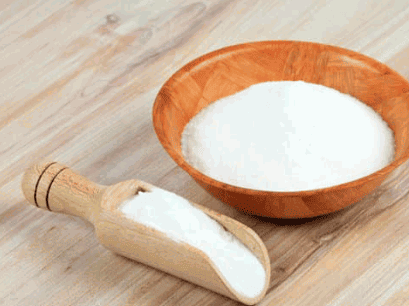
White vinegar is a common ingredient in homemade carpet cleaning solutions due to its acidic properties that help dissolve stains and eliminate odours.
Regarding tackling tough stains, white vinegar stands out as a potent ally. Its acidic nature not only helps to break down stubborn marks on carpets but also works wonders in eliminating lingering odours, leaving your space fresh and clean. White vinegar boasts impressive antimicrobial properties, making it an effective agent in fighting off germs and bacteria that may be lurking in your carpets.
To ensure safe and efficient carpet cleaning, it is recommended to dilute white vinegar with water. A common ratio is a 1:1 mixture of white vinegar and water in a spray bottle for spot treatments. For larger carpet areas, a mixture of 1 cup of white vinegar to 2.5 gallons of water works effectively to lift stains and refresh your carpet fibres.
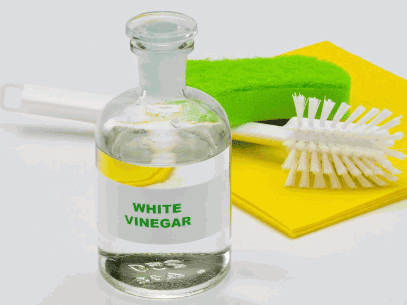
Hydrogen peroxide is a powerful cleaning agent that is used in homemade carpet cleaning solutions to tackle tough stains and disinfect carpet fibres.
One of the key benefits of hydrogen peroxide is its ability to penetrate deep into carpet fibres, targeting stubborn stains and eliminating harmful bacteria. This versatile solution is particularly effective in removing organic stains like blood, wine, or pet accidents, making it a popular choice for carpet cleaning enthusiasts.
When using hydrogen peroxide for carpet cleaning, it is important to dilute it properly to avoid damaging the carpet fibres or causing discolouration. Always test a small, inconspicuous area of the carpet first to ensure compatibility.
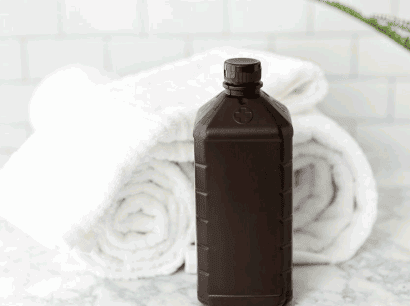
Washing-up liquid is a gentle yet effective ingredient in homemade carpet cleaning solutions, ideal for breaking down greasy stains and dirt particles.
Due to its grease-cutting properties, washing-up liquid can penetrate deep into the carpet fibres, loosening tough oily residues. When applied properly, it helps in lifting the greasy spots and leaving the carpet cleaner and fresher.
When choosing a washing-up liquid for carpet cleaning, opt for a mild and gentle formula without harsh chemicals or added fragrances. Look for labels indicating 'gentle' or 'safe for hands' to ensure it won't damage your carpets.
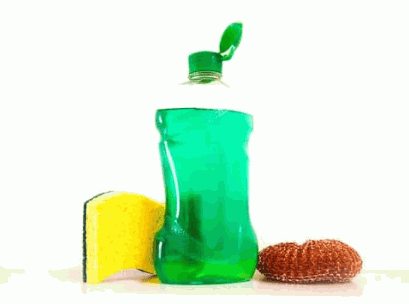
Creating a homemade carpet cleaning solution is a simple and cost-effective process that requires a few key ingredients and minimal preparation.
To start, gather together white vinegar, bicarbonate of soda, hot water, and a few drops of your favourite essential oil for a pleasant fragrance.
The small addition of essential oil not only leaves your carpets smelling delightful but also helps in neutralising any lingering odours.
The basic homemade carpet cleaning solution consists of a blend of water, white vinegar, and dish soap, creating a versatile cleaner for general carpet maintenance.
Water serves as the base of the solution, providing the necessary dilution for the cleaning agents to work effectively.
The combination of these ingredients forms a powerful yet gentle cleaning solution that is safe for most carpet types, offering a cost-effective and eco-friendly alternative to commercial cleaners.
For stubborn stains, a homemade carpet cleaning solution with bicarbonate of soda, hydrogen peroxide, and white vinegar can offer enhanced stain-fighting power.
Bicarbonate of soda acts as a natural deodoriser and gentle abrasive, making it effective at loosening tough stains on carpets. When combined with hydrogen peroxide, it forms a powerful cleaning agent that breaks down organic matter and lifts stains from carpet fibres. White vinegar, with its acidic properties, helps to dissolve alkaline stains and neutralise odours, leaving your carpets refreshed and spotless.
Cleaning carpets with a homemade solution involves a series of systematic steps to ensure thorough cleaning and effective stain removal.
Before applying the homemade cleaning solution, it is essential to hoover the carpet to remove surface debris and prepare it for deep cleaning.
Hoovering is the first and crucial step in maintaining the cleanliness and longevity of your carpets. By removing loose dirt, dust, and other particles, hoovering prevents these from embedding deeper into the carpet fibres during the cleaning process. A key tip for effective hoovering is to go over each area multiple times, especially high-traffic zones, to ensure thorough removal of debris. Using the right attachment tools, such as a crevice tool for corners and edges, can help reach hidden dirt and achieve a more comprehensive clean.
Dig deeper: Can You Steam Clean Carpets
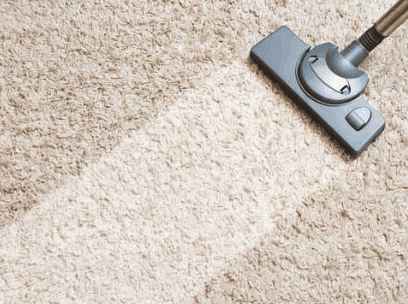
Before full application, always test the homemade cleaning solution on a small inconspicuous area of the carpet to ensure compatibility and avoid potential damage.
By conducting a patch test, you can identify any colourfastness issues that might arise when applying the solution. This small precaution can save you from ruining the entire carpet due to incompatibility with the cleaning ingredients. It also serves as a preventive measure against adverse reactions, ensuring that the cleaning solution is safe for use on your carpet. Remember, a simple test spot can help you gauge the effectiveness and safety of the cleaning solution, giving you peace of mind when treating the entire carpet.
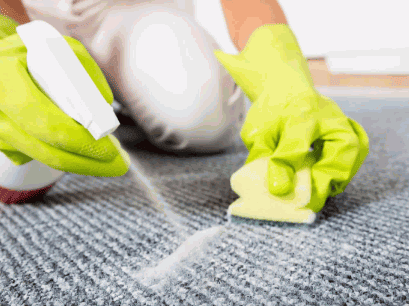
Using a spray bottle or cloth, apply the homemade cleaning solution to the stained area of the carpet, ensuring thorough coverage for effective stain removal.
Gently scrub the stained area with a soft-bristled brush or cloth to agitate the cleaning solution and lift the stain from the carpet fibres.
When scrubbing, it is crucial to use gentle motions to prevent any potential damage to the delicate carpet fibres. Avoid harsh scrubbing as it can fray or weaken the fibres, leading to permanent damage.
For different carpet textures, choose appropriate brush types. A soft-bristled brush works well for most carpets, but for shaggy or high-pile carpets, opt for a brush with longer bristles to reach deep into the fibres without causing tangling.
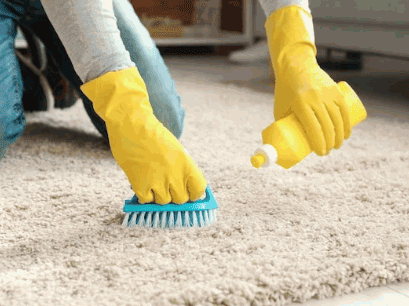
After scrubbing, blot the treated area with a clean cloth or kitchen roll to absorb excess moisture and lift the loosened stain particles from the carpet.
Remember, when blotting, avoid rubbing back and forth as this can push the stain deeper into the fibres of the carpet. Instead, gently press the cloth onto the stained area, allowing it to soak up the moisture and residue without spreading it. Ensure the cloth is clean and absorbent to effectively lift the stain without causing further damage.
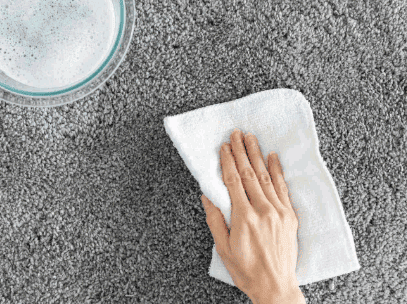
Thoroughly rinse the cleaned area with water to remove any remaining cleaning solution and residue, ensuring a fresh and residue-free carpet surface.
To effectively carry out the rinsing process, it is recommended to use lukewarm water for optimal results. Lukewarm water helps to break down any remaining soap residue while not damaging the fibres of the carpet. Employing gentle pressure when rinsing is crucial to thoroughly flush out any cleaning solution remnants. You can use a spray bottle or a hose attachment with a gentle spray setting to evenly distribute the water across the cleaned area.
Remember that inadequate rinsing can lead to soap buildup on the carpet, causing it to attract more dirt and grime over time. Proper rinsing ensures that your carpet remains clean and fresh for a longer period. A helpful tip is to blot the area with a clean towel after rinsing to absorb excess water and aid in faster drying.
Once the cleaning process is complete, allow the carpet to air dry or use fans to expedite the drying process and prevent mould or mildew growth.
Proper drying is crucial in maintaining the freshness and longevity of your cleaned carpet. Moisture trapped in the fibres can lead to odours and potential mould issues.
To enhance air circulation, open windows and doors in the room. You can also position fans strategically around the carpet to speed up the drying time. A dehumidifier can be useful in removing excess moisture from the air. Remember, a well-dried carpet not only looks better but also ensures a healthier environment in your living space.
To maximise the effectiveness of a homemade carpet cleaning solution, follow these essential tips for optimal results and carpet maintenance.
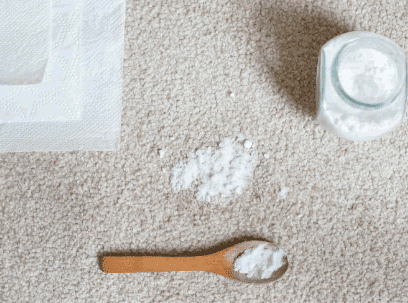
Avoid over-saturating the carpet with the cleaning solution to prevent excessive moisture build-up and potential damage to the carpet fibres.
When applying a cleaning solution, remember that less is more. It's crucial to strike a balance between effectively removing stains and preserving the integrity of your carpet.
Monitoring the saturation level and blotting excess solution promptly can make a significant difference in the cleaning process.
When blotting the carpet, always use a clean cloth or kitchen towel to absorb moisture and stain residues without transferring dirt or contaminants back onto the carpet.
Using a clean and absorbent cloth is crucial in this process to ensure that the stain is effectively lifted without causing further damage to the carpet fibres. Opt for microfibre cloths, white cotton cloths, or soft towels as they are gentle on the carpet surface and have good absorbency properties.
These cloth types are ideal for blotting because they do not leave fluff or fibres behind, which could potentially stick to the damp carpet and complicate the cleaning process. By using the right cloth, you can effectively target the stain and prevent it from spreading or setting deeper into the carpet fibres.
Before applying the cleaning solution to visible areas, always test it on a small, inconspicuous section of the carpet to verify compatibility and avoid unexpected damage.
Conducting a patch test prior to full application is a crucial step in ensuring that the cleaning solution does not harm the carpet fibres or cause discolouration. This simple test can save you from potentially costly mistakes.
Choose a spot that is hidden from view, such as under furniture or along the edges, and follow the instructions provided by the manufacturer of the cleaning product. Taking these precautions can prevent undesirable outcomes and preserve the quality of your carpet.